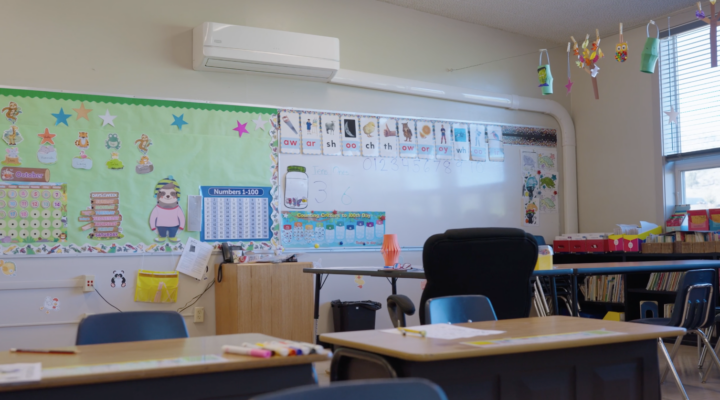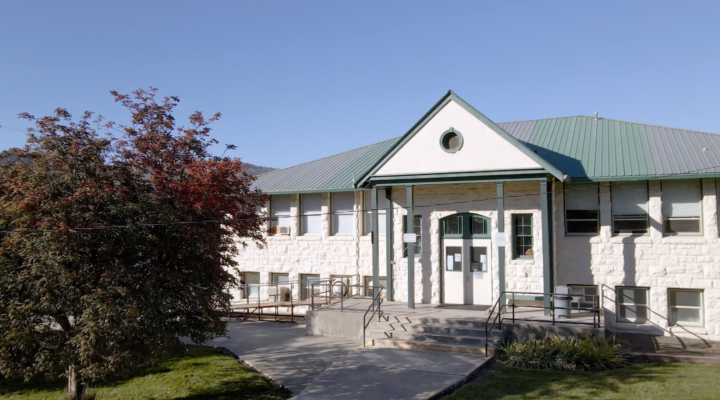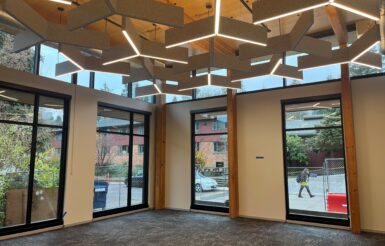When a 25-year-old HVAC system increased energy costs and negatively impacted the learning environment for students and teachers, the administrators at Monument School in Monument, Ore., sought a healthier and more efficient solution. Hear from school and utility staff members on how the very high efficiency DOAS approach to HVAC design dramatically reduced the rural K-12 school’s monthly energy costs, significantly improved their air quality, reduced viral spread, and provided a far more comfortable and productive learning environment.
Project Overview
Rural elementary school seeks healthier, more comfortable learning environment.
Motivated to improve the air quality and thermal comfort of their elementary school while reducing monthly energy costs, school administrators of Monument Grade School in Monument, Ore., sought a new HVAC solution.
The single-story building was built in 1965 and heated by 25-year-old heat pumps supplemented by multiple space heaters in each classroom during the winter. Other than operable windows, ventilation in the classrooms was provided by manually controlled exhaust fans operated by teaching staff when rooms became stuffy. These previous exhaust fans let in uncontrolled and unconditioned air, leading to inconsistent thermal comfort and sub-optimal indoor air quality for students, teachers and staff.
This, combined with a desire to reduce their monthly energy costs, compelled the school’s administrators to seek out an advanced HVAC approach that could fulfill all their HVAC needs in one fell swoop.
High-performance HVAC turns in comfort, air quality and energy savings.
The school’s administrators found their answer in the very high efficiency dedicated outside air system (very high efficiency DOAS) approach. Representing the next step in the ongoing evolution of HVAC design, very high efficiency DOAS utilizes the most efficient HVAC systems (such as ductless heat pumps and heat recovery ventilators) and design principles to provide cleaner and safer indoor air, while reducing commercial building HVAC energy use by an average of 65%.1
Utilizing heat recovery ventilation to save energy, very high efficiency DOAS combines high-efficiency HVAC equipment with the dedicated outside air system (DOAS) approach that separates heating and cooling from the ventilation. This separation allows for optimal and efficient control of each critical building function while circulating 100% fresh and filtered outdoor air throughout the building.

Results
The result is a healthy and efficient approach to HVAC that reduces overall commercial building energy use by an average of 36%.
By significantly reducing or eliminating the recirculation of air between spaces, very high efficiency DOAS reduces the recirculation of pollutants and contaminated air to improve occupant health, comfort and overall satisfaction.
The school’s new approach to HVAC benefits the students, teachers, staff and building operators by providing:
- Better indoor air quality due to filtered 100% outside air brought into the space, with little recirculation
- Increased occupant comfort through improved temperature stability and the ability to create zones with unique temperature controls
- Improved occupant productivity by improving indoor air quality and comfort
- Lower energy bills
Conversion summary
| Pre-existing HVAC system: | 5x 2.5-ton unitary heat pumps, plus 1-3 space heaters in each classroom |
| New HVAC system: | 5x 2-ton ductless mini-split heat pumps 1x 1.5-ton ductless mini-split heat pump 1 Ventacity VS1000RT HRV |
Healthy air for better learning
By choosing the very high efficiency DOAS approach, the school administrators chose to prioritize not only the thermal comfort of their students and teachers, but their health and safety as well. They knew that very high efficiency DOAS could enhance classroom air quality and support student and teacher health by reducing the spread of infectious diseases like the flu and Covid-19.2.
While many effective HVAC approaches can increase the ventilation rates and health of occupants, most also dramatically increase energy costs. Very high efficiency DOAS, on the other hand, provides 100% filtered outside air to decrease contaminant spread, and uses significantly less energy than competing high-ventilation approaches.
Now more than ever, HVAC design requires careful attention to ensure safe, clean air for students and teachers. By employing the very high efficiency DOAS approach, Monument School found a healthier solution that also reduces the overall costs of building operation.
In addition to cutting the building’s HVAC energy use in half, the very high efficiency DOAS approach left teachers and staff praising the healthier, fresher air and increased temperature control. Very high efficiency DOAS gives teachers and parents peace of mind on several fronts—in addition to increasing indoor air quality, the school was able to remove multiple uncomfortable space heaters in each classroom.
The project further resulted in a reduction of 16 metric tons (35%) in greenhouse gas emissions (GHG) annually.
In the 12 months following the very high efficiency DOAS installation, utility data suggests that the school has reduced their energy use by almost 60,000 kWh (60% HVAC energy use reduction), when compared to the previous system and when normalizing for weather. Though this utility data is based on a single utility meter that serves the entire campus, there is nevertheless a noticeable reduction in HVAC energy use shown during the period of November 2019 through October 2020 when compared to the previous two years before the conversion.

Sources:
- Twelve real-world demonstration projects by Northwest Energy Efficiency Alliance, as compared to code-minimum systems.
- Based on findings from NEEA’s 2021 Covid-19 Risk Reduction Strategies and HVAC System Energy Impact Report: betterbricks.com/resources/covid-19- hvac-risk-reduction-strategies.
- Reported GHG emissions reduction is based on the following assumptions: 1) 11.7 pounds of CO2 per therm of natural gas saved, 2) 0.91 pounds of CO2 per kWh avoided (Source: Northwest Power and Conservation Council’s latest report from 2018 on avoided CO2 rates in the Northwest).



